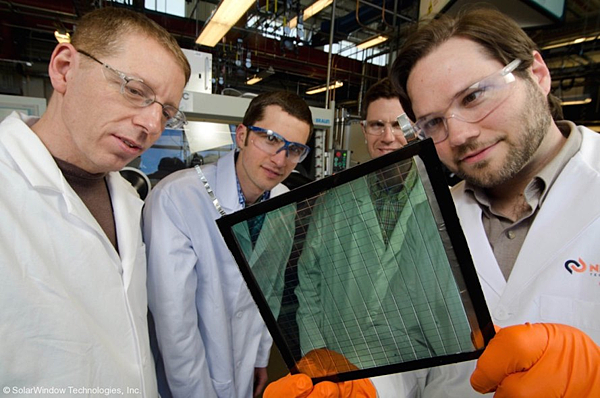
“Luminescent solar concentrators (LSCs)” are a key component of the team’s solar windows,” according to a statement from the National Laboratory. LSCs can collect sunlight over large areas, and function as “light-management devices.” They collect sunshine via colloidal quantum dots, which have beneficial properties such as the ability to withstand light hitting them over and over. Colloidal quantum dots have a “high photostability,” which means sunlight won’t break them down.
Fluorophores in the LSCs also help the windows do their job. After light is collected, the chemical compounds re-emit photons. Photovoltaic cells can then collect the photons after they are guided towards the cells via “total internal reflection.”
The team used a “doctor-blade” technique to create the LSC windows. This technique is often used in printing to remove excess ink and leave behind a uniform film. The scientists drew on the printing technique to add a thin, uniform layer of a “dot/polymer composite” on large glass slabs that could be put into buildings. Lead scientist Victor Klimov said the solar windows could “turn presently passive building facades into power generation units.”
As detailed in their research published online by Nature Energy this week, the scientists hope the use of LSCs could reduce solar power costs. Their solar windows likely wouldn’t need as many “expensive photovoltaic materials” as other solar modules. They also noted solar windows would be incredibly beneficial for urban spaces, where there may not be as much room for solar panels.
The concept of transparent solar cells that would transform glass-clad skyscrapers into solar farms and turn smartphone screens into solar panels is exciting, but nothing new. Last year, Michigan State University scientists unveiled a fully transparent solar concentrator that allows visible light through and uses organic molecules to guide ultraviolet and infrared wavelengths to the edges of the glass, where tiny photovoltaic cells turned the non-visible light into electricity. However, conversion efficiency for that prototype was only at 1%, whereas traditional solar panels typically reach 20 to 25% conversion efficiency.
Related: Crystal Clear Solar Panels Could Turn Your iPhone Into an Energy Generator
SolarWindows Technologies is a different story. Today’s webinar mentioned that the coatings would be primarily organic—made mainly from carbon, hydrogen, nitrogen, and oxygen—but was vague on the scientific details. However, if SolarWindows are expected to produce 50 times the energy of traditional PV cells we can probably assume they’ll be converting visible light into electricity as well. There are a number of different layers in the coating, but the most important ones the company touched on are the Active layer, where electricity is generated by absorption of light, and the Transparent conductors, which allow the electricity to be extracted. The liquid coatings would be applied at ambient pressures and dried at low temperatures to produce transparent films.
The SolarWindows coatings would be applied to the inside of a glass-insulated window unit, not on the outside in order to protect the solar cells from the elements. To cut down costs, the coatings are developed for seamless integration into existing glass manufacturing processes. To generate 50 times the power of conventional photovoltaics, the SolarWindows would be applied all sides of the building rather than just the roof. “Invisible wires” in the glass convert photons into electricity and help provide a visual reference to prevent birds from crashing into the glass. The company also believes the technology can achieve a commercially viable 25-year warranty, which is the same lifespan shared by conventional solar panels.
While the numbers may seem too good to be true—SolarWindow Technologies also says that a “single installation can avoid 2.2 million miles of carbon dioxide vehicle pollution; 12 times more than [conventional] solar”—the company is planning to deliver on their promises soon. SolarWindow Technologies announced that they would commercialize their innovative and cost-effective technology within the next 28 months.
Source:http://inhabitat.com/national-laboratory-scales-up-quantum-dot-solar-windows-to-power-entire-buildings/





 留言列表
留言列表